Have you ever wondered how best to handle your chin? Well, wonder no more! Here’s a quick video to help guide you on your start to safely holding, transporting, and handling your chinchilla.


Have you ever wondered how best to handle your chin? Well, wonder no more! Here’s a quick video to help guide you on your start to safely holding, transporting, and handling your chinchilla.

While photographing chinchillas can be challenging, its rewards are adorable and its cuteness nearly unmatched. However, aside from taking your chinchilla photography to the next level through creating adorable sets, there is another medium which is much more true-to-life and far more engaging: videography.
Chinchilla videos allow for additional dimensions of sharing: movement, sounds, and quirky personalities shine! But creating and editing videos is a time-consuming process that may seem daunting for new videographers. No fret – I’ll help you break down the requisites to create compelling pet videos without getting overwhelmed. There are a few steps to consider when it comes to the video-creation process: conceptualization, setup, videoing, post-production, and sharing. Read on, and you’ll be creating delightful videos in no time!
There are a few steps to consider when it comes to the video-creation process: conceptualization, setup, videoing, post-production, and sharing. Read on, and you’ll be creating delightful videos in no time!
Each great video starts with an epic theme: cuteness. But the question is, what kind of cuteness do you want to capture? Sometimes it’s fun to play into a certain theme or creative concept, such as “Paranormal Chintivity” or “CHINN Breaking News: Ebola Cure Found,” there’s always room in the webiverse for no-frills, simple shots of your adorable fluffballs. While creating sets and developing themes is always fun, don’t forget to manage expectations. Every single set I’ve created for the fluffs has been thoroughly destroyed by the end of filming – and certainly, with all the destruction and re-takes, these videos require more post-production than a simple scene. If you’re just starting out, simplicity is key. A well-lit room (I prefer natural light always, but artificial light is also helpful when needed) and a chin-comfortable environment are the two must-haves for your chin’s YouTube success.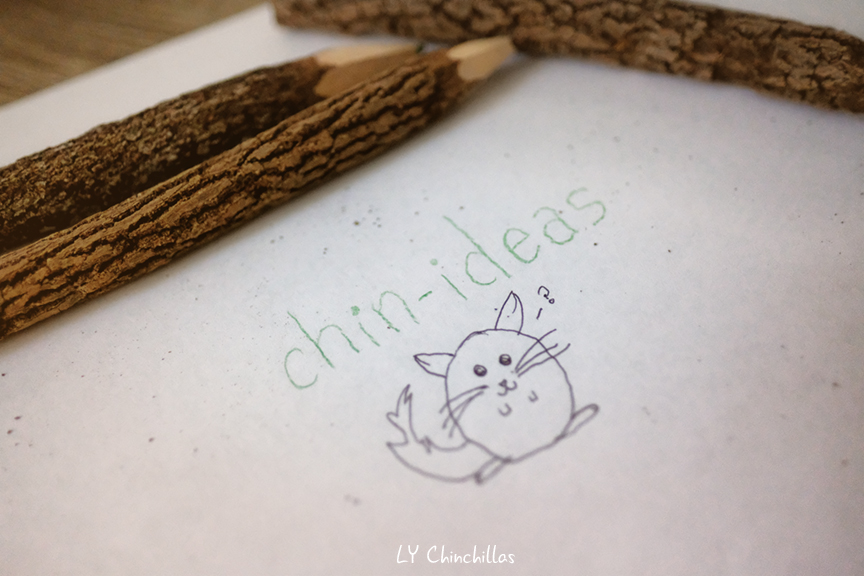 Another important question to ask is: how well do you know your chinchillas? Of course there will always be natural variables to every chinchilla’s behavior, but you should be in a comfortable enough place in bonding and learning your chin’s general demeanor. For example, I’d say “Muff’s not going to do well in a large, unconfined area. He’s a speed demon on the open road!” or “Koko Bear loves cuddling and massages. She’ll be a perfect cuddle or scratchies video subject!” or “Lulu and Fifi are wildcards! It’s pretty safe to say they’ll be little troublemakers on a hand-crafted set,” or “Mitty is an intelligent divo. He’s going to either give us incredible angles or ignore the camera entirely… likely a mix of both.” These kinds of insights into your fluffy ones will be the foundation upon which your video relies. Pick a personality and a setting to fit.
Another important question to ask is: how well do you know your chinchillas? Of course there will always be natural variables to every chinchilla’s behavior, but you should be in a comfortable enough place in bonding and learning your chin’s general demeanor. For example, I’d say “Muff’s not going to do well in a large, unconfined area. He’s a speed demon on the open road!” or “Koko Bear loves cuddling and massages. She’ll be a perfect cuddle or scratchies video subject!” or “Lulu and Fifi are wildcards! It’s pretty safe to say they’ll be little troublemakers on a hand-crafted set,” or “Mitty is an intelligent divo. He’s going to either give us incredible angles or ignore the camera entirely… likely a mix of both.” These kinds of insights into your fluffy ones will be the foundation upon which your video relies. Pick a personality and a setting to fit.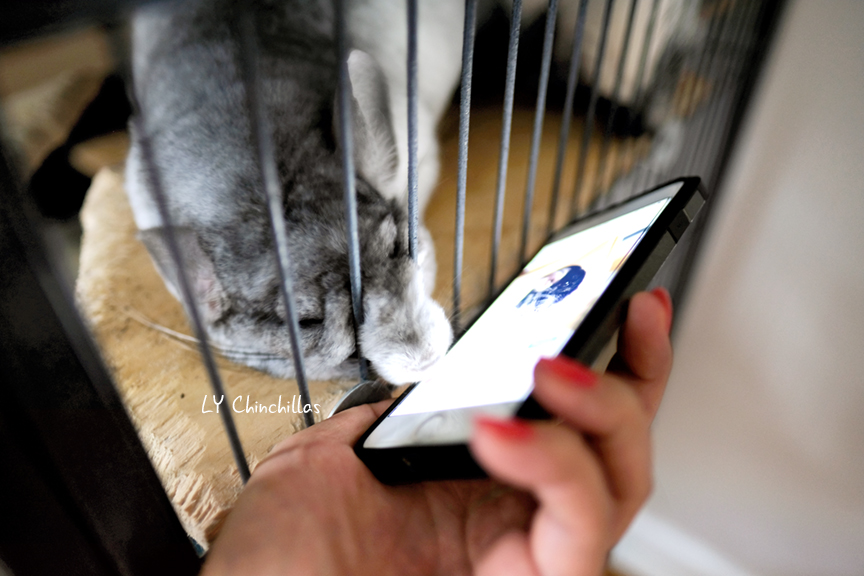
If you’re just starting out, it’s a great idea to start out in-cage to prevent your chinchilla from behaving sporadically due to being filmed in a new environment. Try to pick a time of day where your chin will be between sleepy and feisty – normally, midday works pretty well, between naps. This will also allow for the most amount of natural night for filming.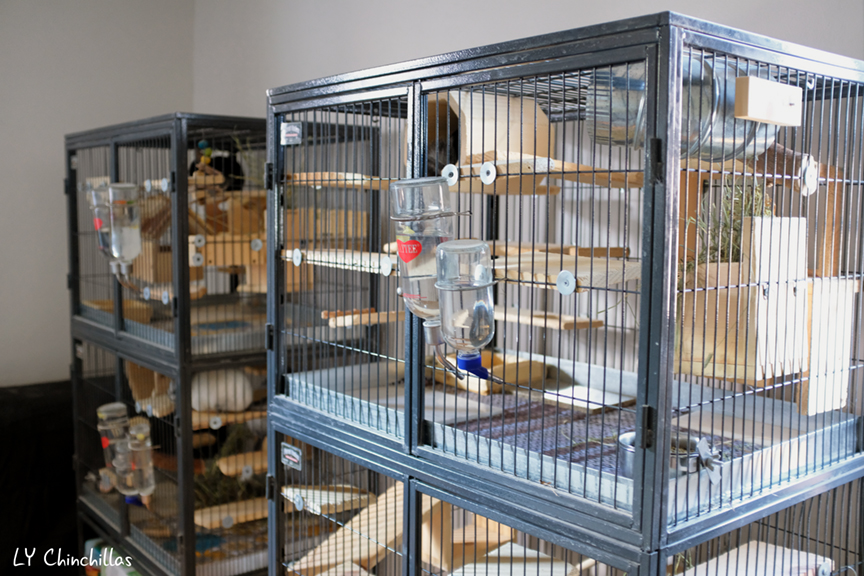 After a while, if you’ve become comfortable with in-cage videoing, you can start to get a bit more creative by moving your set to another area of the house. Great places are confined playroom areas such as closets, bathrooms, and other properly chinchilla-proofed spaces.
After a while, if you’ve become comfortable with in-cage videoing, you can start to get a bit more creative by moving your set to another area of the house. Great places are confined playroom areas such as closets, bathrooms, and other properly chinchilla-proofed spaces.
In order to put as much of the focus as possible on your little best friend, it’s important to make sure each area is as clean as possible. If in-cage, take the time to clean. If out-of-cage, same thing (+ chin-proofing). It may seem redundant and unnecessary, but the filming process and final output will thank you!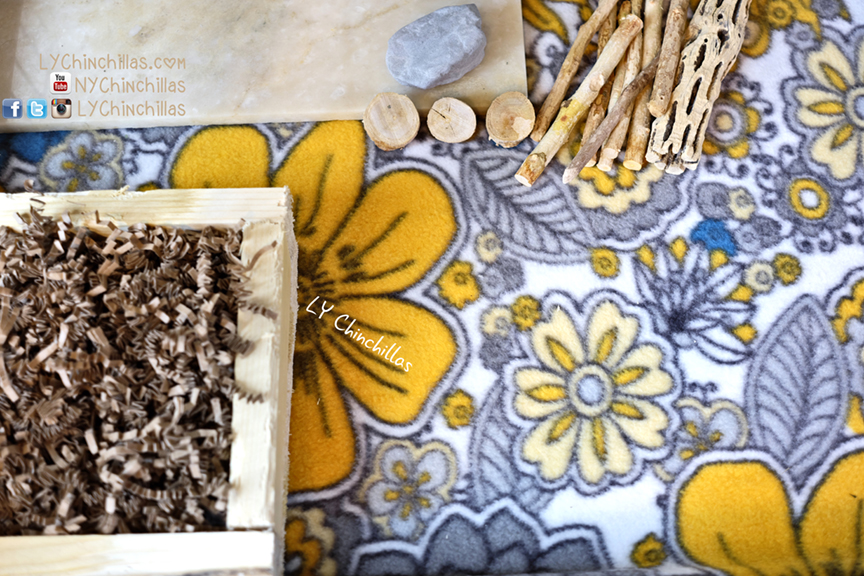
There are plenty of options when it comes to the best gear to choose. Of course, still photography is one thing. Videography may seem similar, but there are a few more factors to consider with regards to this medium: ease of use and desired output.
While the bulk of our current YouTube videos are created with the latest iPhones, I have been taking more time and energy to create more beautiful and artistic videos with the 4K options that FUJIFILM X Series cameras have to offer. My go-to camera choices for video capture is the FUJIFILM X-T2 or X-T20, both boasting beautiful 4K with film simulation overlay options. I love the X-T20’s touchscreen LCD focus, which makes capturing moving fluffballs as much of a breeze as possible. Both options are mirrorless, meaning they’re lighter and easier to use than DSLRs. A few of my favorite lenses for creating lovely video shots are the XF50mmF2 and XF16mmF1.4 for cinematic vibes. If you need an extra hand, try using a tripod to help steady your takes. I also love the XF10-24mmF4 and XF50-140mmF2.8 for the epic OIS (optical image stabilization), which minimizes shakiness (typical to iPhone output), and diversity of focal lengths in the zooms. If you’re working alone, OIS will come in handy when you’re shooting handheld.
A few of my favorite lenses for creating lovely video shots are the XF50mmF2 and XF16mmF1.4 for cinematic vibes. If you need an extra hand, try using a tripod to help steady your takes. I also love the XF10-24mmF4 and XF50-140mmF2.8 for the epic OIS (optical image stabilization), which minimizes shakiness (typical to iPhone output), and diversity of focal lengths in the zooms. If you’re working alone, OIS will come in handy when you’re shooting handheld. 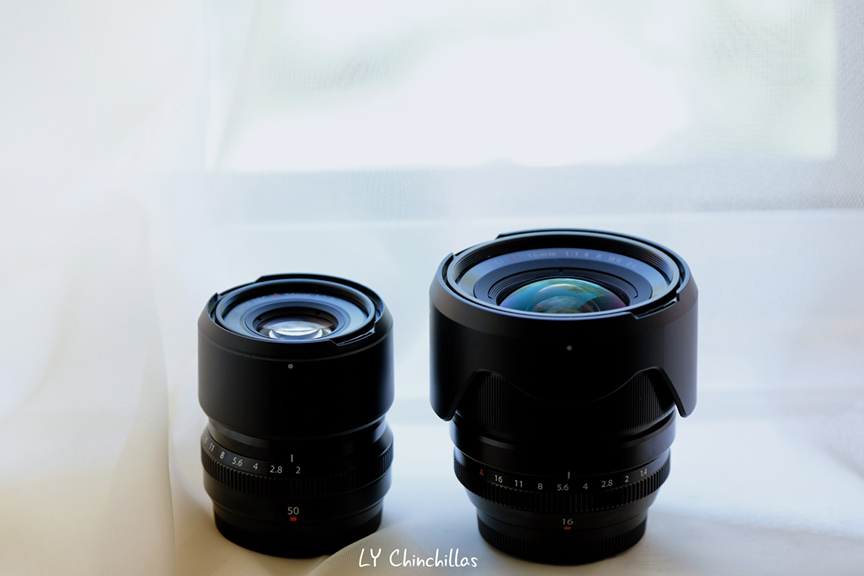 So, which option is best for you: a smartphone, or a professional camera? It comes down to what you’re comfortable with and what kind of feel you want to convey in your videos. Oftentimes, a phone is all that’s available when something supercute happens out of the blue – making it perfect for those quick snaps and adorable memories. However, if you’re putting the time into a concept and setup, you should consider a more professional system for more epic chinchilla videos.
So, which option is best for you: a smartphone, or a professional camera? It comes down to what you’re comfortable with and what kind of feel you want to convey in your videos. Oftentimes, a phone is all that’s available when something supercute happens out of the blue – making it perfect for those quick snaps and adorable memories. However, if you’re putting the time into a concept and setup, you should consider a more professional system for more epic chinchilla videos.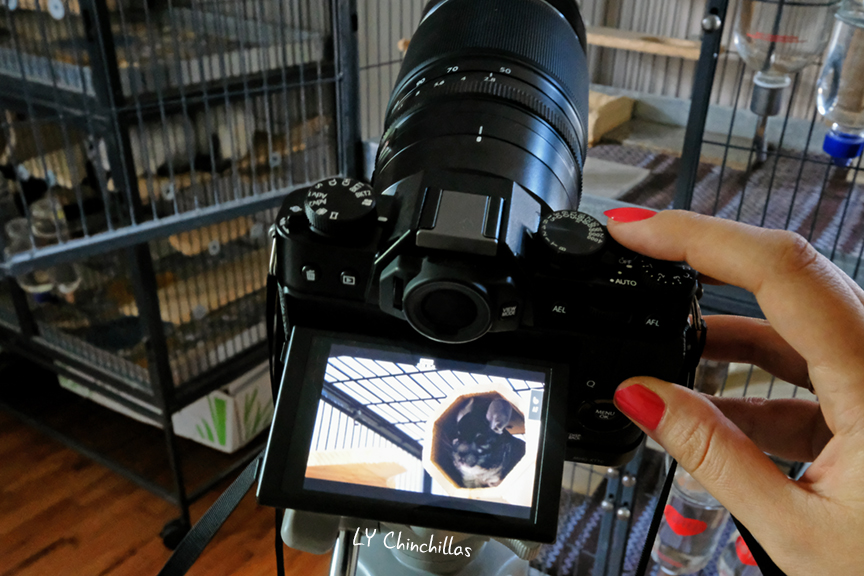 Gear aside, don’t get discouraged when you’re shooting – remember, there’s an inherent learning curve in all new and worthwhile endeavors. Try to time your filming on a treat day – don’t overindulge your chins, but if they’re on schedule for a treat, this is a great overlap. If you don’t get the shot, take a break and try again. If today’s not your day, maybe tomorrow is. Oftentimes, a patient and relaxed approach will yield the best possible results.
Gear aside, don’t get discouraged when you’re shooting – remember, there’s an inherent learning curve in all new and worthwhile endeavors. Try to time your filming on a treat day – don’t overindulge your chins, but if they’re on schedule for a treat, this is a great overlap. If you don’t get the shot, take a break and try again. If today’s not your day, maybe tomorrow is. Oftentimes, a patient and relaxed approach will yield the best possible results.
The easiest way to share is to simply upload your captured video to your favorite social website, no frills and no post-production. This also means no post-production: no color correction, frame adjustments, splicing/cropping, or intro/outros – but it sure does get your chinchilla’s cuteness out there as fast as possible!
While that’s an expeditious method, I’m going to dive a little deeper into your alternatives if you’re looking to invest a little more time and energy into your post.
Apple’s iMovie is one of my favorites: it’s incredibly easy to use, and the learning curve is very mild if you’re a regular smartphone user. This is how the bulk of our videos were created, and the software is certainly good enough for most videographers operating in the pet-video-creation realm. Final Cut Pro or Adobe Premiere Pro are great options for the more technically-savvy out there. These two are definitely professional grade software; a bit more difficult to learn than a simple interface like iMovie. However, it’s worth putting in the time, pulling up a few YouTube tutorials, and getting deeper into the edit! There are a lot more options in these types of technologies than a simpler interface can offer. To get started, a simple YouTube How-To search will get you where you need to go!
Final Cut Pro or Adobe Premiere Pro are great options for the more technically-savvy out there. These two are definitely professional grade software; a bit more difficult to learn than a simple interface like iMovie. However, it’s worth putting in the time, pulling up a few YouTube tutorials, and getting deeper into the edit! There are a lot more options in these types of technologies than a simpler interface can offer. To get started, a simple YouTube How-To search will get you where you need to go!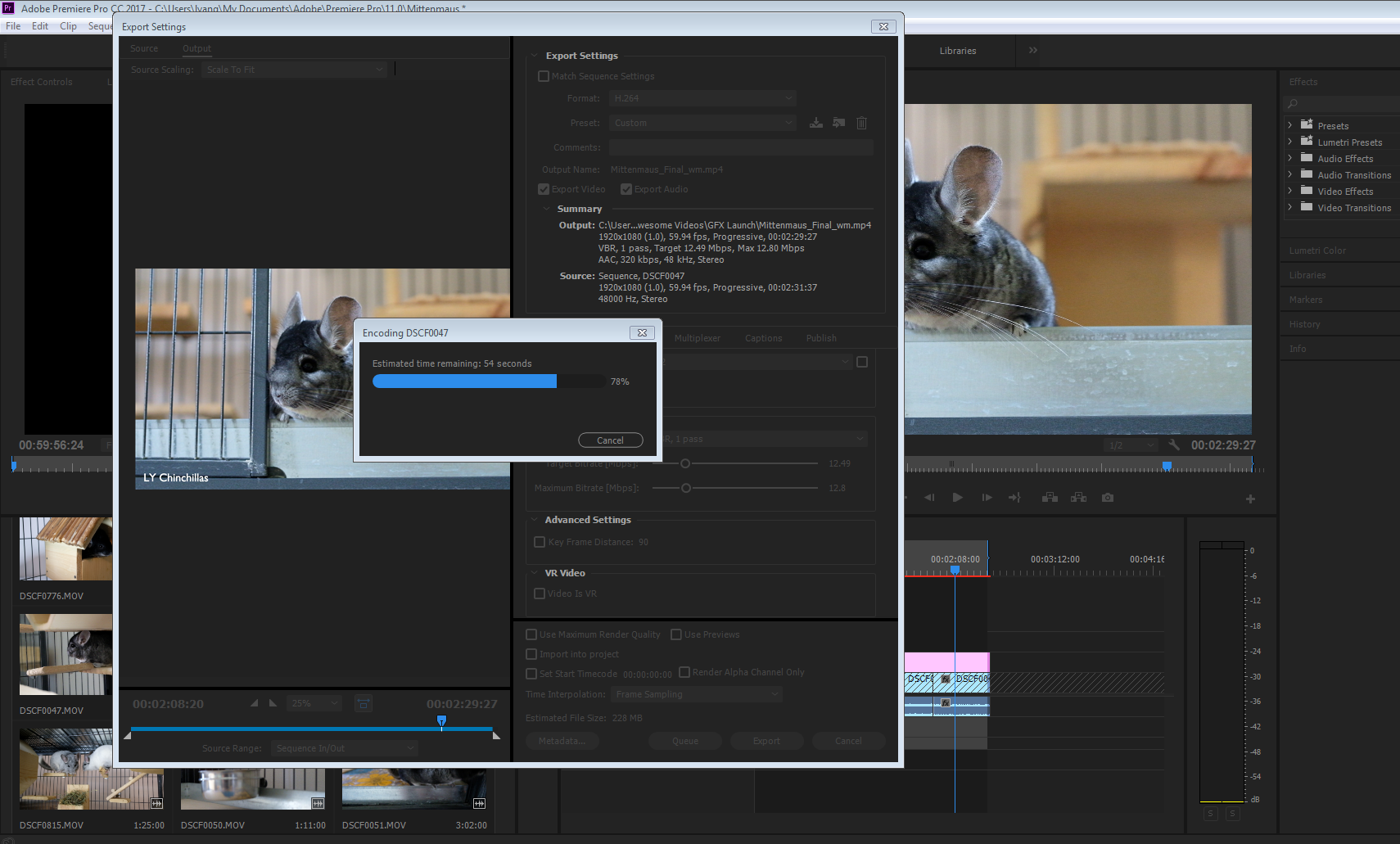 There are also a plethora of other post-production options out there, but those are the ones we’re comfortable with! If you have any other favorites, feel free to comment and share with us.
There are also a plethora of other post-production options out there, but those are the ones we’re comfortable with! If you have any other favorites, feel free to comment and share with us.
YouTube, Instagram, and Facebook are our all-time favorite sharing platforms. But, it’s really up to who you want to see your videos and how you want to share your chinchillas with the world. They’re definitely cute enough that they deserve to be shared, and you know it! Be sure to have fun and create a sense of community while you’re at it.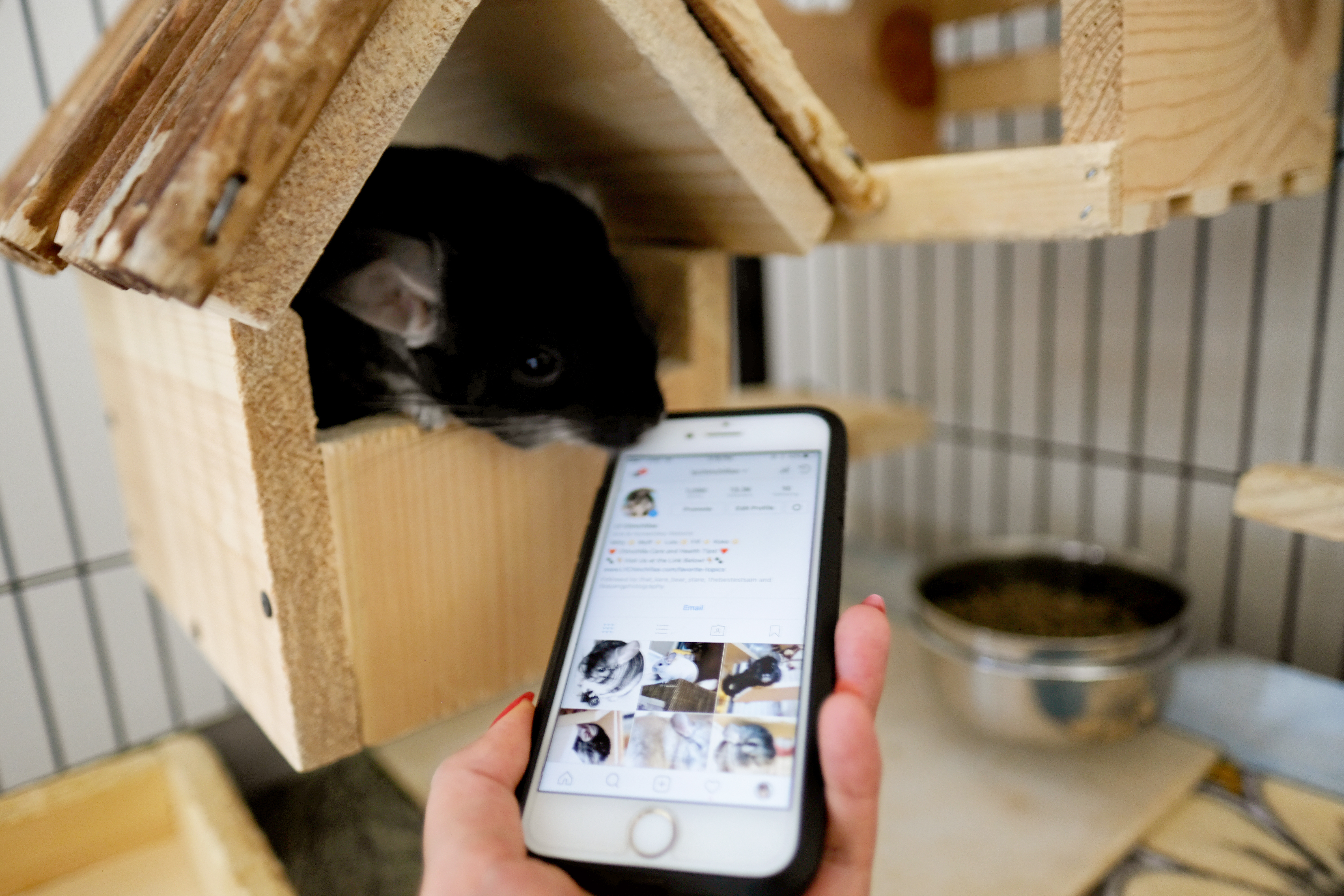
There you have it: the five simple steps to creating adorable chinchilla videos. Take this summer as a time to keep your chinchillas cool and creating even cooler videos! Don’t forget to check out our official YouTube channel here! There are a ton new videos on their way, just hit subscribe and enjoy the pawdorable fluffs. 🙂

LY Chinchillas Treat Donation
Donate healthy, delicious treats to LY Chinchillas to help keep our content going!
$5.00
As a chinchilla owner, sometimes the world beckons you away from the life of a stay-at-home chin-slave guardian. When the sweet oceanside breeze or faded sirens of some delightful foreign city tug at your heartstrings, you begin to remember what life was like before owning a chinchilla.
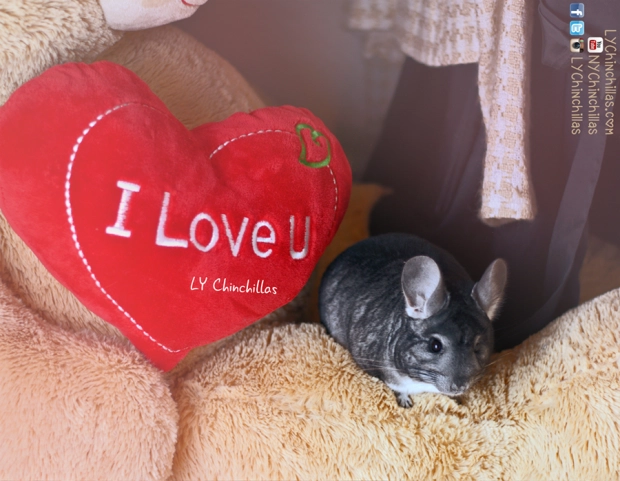
All the feeding, cleaning, dusting, weighing, and constant bonding efforts can get overwhelming at times – not to mention the cage building, cage purchasing, DIY cage accents and hanging toys, cookie making, perpetual safeguarding against plastic, hefty air conditioning/dehumidifier bills, and constant provision of chin-safe chews, occasional chin-proofed playtimes, and continual supply of soft entertainment. And if you think that’s a handful, it’s just the start! For very loving chin-owners, chinchilla ownership is a way of life and chinchilla care and parenthood is just as much a part of your daily routine as work, friends, or school! They’re family! Honestly, caring for a chinchilla properly is time, energy, and money-consuming, but that smug smile on their fat, furry faces is worth every ounce of trouble! For new or potential owners, just go ahead and skip to our post all about chinchilla care basics to gather a light gist of what your fluffy workflow will be like.
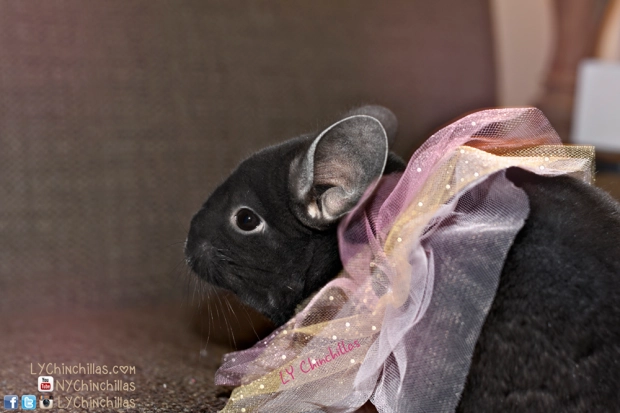
So, back to that wanderlust dreamscape: island sunrise, countryside mountaintop, or city retreat. Maybe you’re thinking of leaving for a weekend, or flying off for a few weeks – after all, you’re a hardworking chin-parent, you deserve it! What’s the best course of action when you can’t take your babies with you? Let’s chat about chin-sitters! Inevitably, at some point in your chin’s very long and happy life with you, you will likely have to leave your beloveds in the care of a third party. This post is all about how to select and direct the perfect chinchilla sitter, and make sure your fluffs are well-cared for in your bittersweet absence.
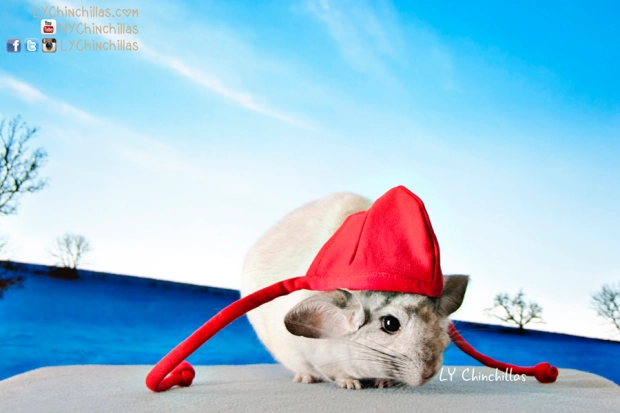
Step 1: Find your potential sitter. I’m lucky: I have an incredible family that lives close and are well-versed with my chinchilla obsession – they’ve endured endless lectures from me on chinchilla health and safety. Ideally, a family member or very close friend would be the best choice – someone who lives nearby, so you always have a reachable emergency contact. It’s best to find a sitter well in advance, as it’s all about availability and suitability.
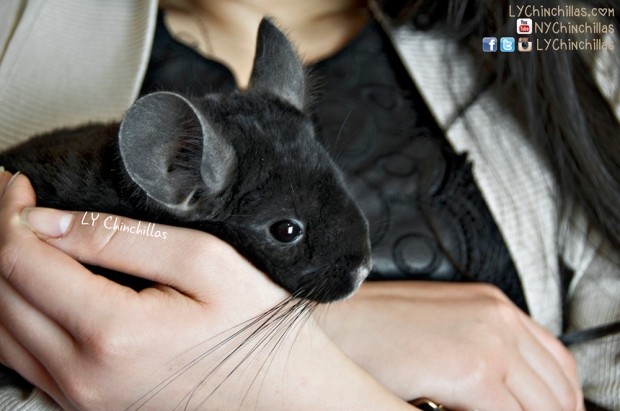
Step 2: Provide all necessary information to your sitter. I make a very thorough document touching on all major points, as well as directing them to this blog to find additional information. Of course, they can contact me at anytime through any social media platform, phone, or email in order to obtain additional information. Adding in the number of your exotic vet is always a great move, too. I always try to drive home the idea that this incredibly important document will be their chinchilla bible for the duration of their stay. Instructions should typically be much more conservative than the way you care for your chins, taking into account the differentiation in familiarity and knowledge of your particular chinnies.
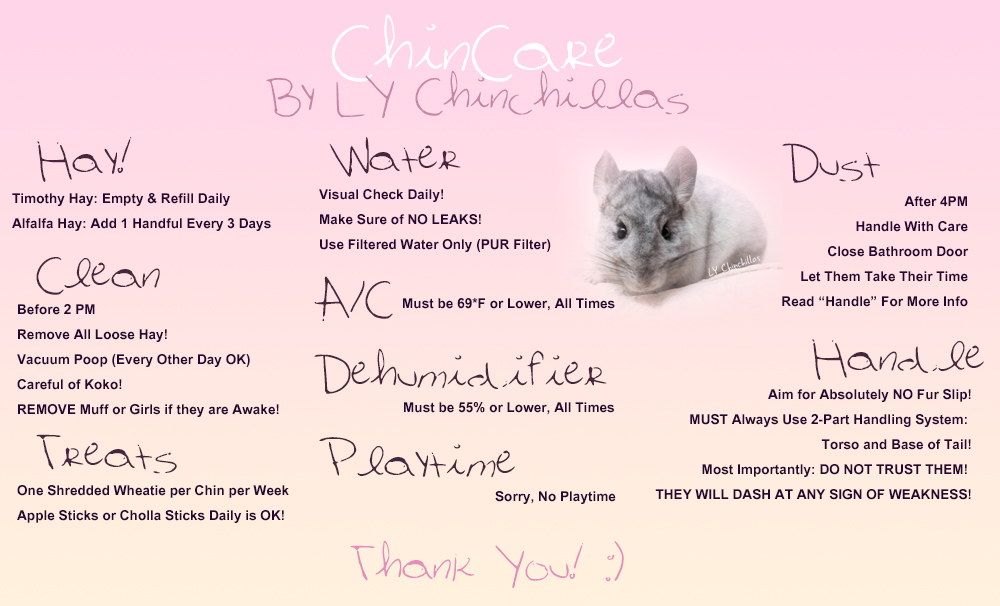
Step 3: Test your potential sitter. After allowing sitters to review information, I’ll invite them over each day for several days in order to test their ability to handle, feed, dust, and care for the chins. I typically skip imposing the daily weighing routine while I’m away, as it is more involved than the other care elements and requires a deeper understanding of each chinchilla in order to successfully weigh them. I’ll always ask a few questions as I watch them work, including a few “what if” situations for good measure.
I was asked recently about why my playtime rules are so conservative. To elaborate, I’m all about playing it safe with my babies – especially given new circumstances, people, or events. Too many things can go wrong if your sitter isn’t completely trained for playtime, so I err on the side of caution. Every chinchilla is unique, and some are crazier than others (cough, Muff!); each new variable equates to a slew of new, potentially harmful results. Playtime is, in general, optional based on the opinion of each chinchilla owner. Additionally, playtime is not crucial in any means to a chin’s general health, so skipping a few sessions couldn’t possibly hurt them. On the other hand, overheating, fur slip, stress, or injury could. The most nightmarish situation I could think up would be a chinchilla injury occurring while I’m not home with no concrete proof of how, why, or when. I’d personally wait until I was home to conduct any playtimes, but everyone is different! Who knows, you could know a true chinchilla guru – but that would still be a risk you’d have to be willing to take as a responsible pet owner.
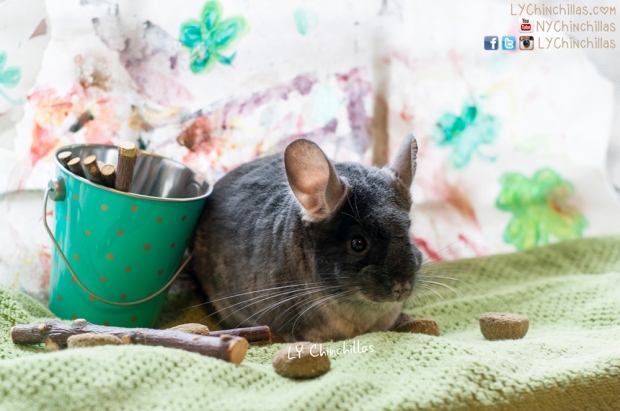
Step 4: Buy a webcam! This is a great piece of technology that every chinchilla owner should buy, as it captures what your chin-sitter may neglect. I position the cam between the cages and angle the cages so I can see everything: water bottles, hay feeders, pellet bowls, and so on. Additionally, I’ll always position my thermometer close enough to the webcam in order to monitor their environment from afar. I have a webcam that’s easy to check via phone and even allows me to coo or sing to them from another zip code!
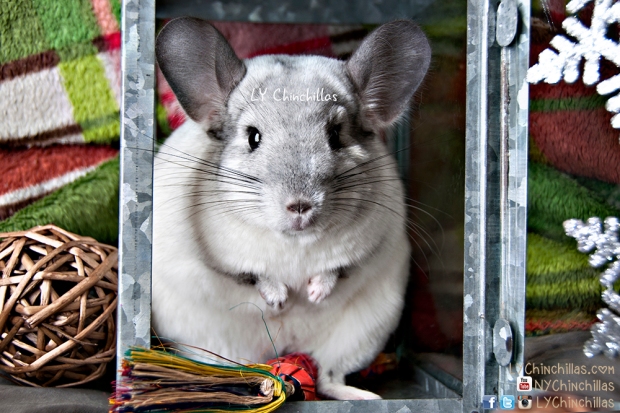
Step 5: Check in with your sitter every day. Text, call, or email! A short catch-up on your chin’s day is always in order. Of course, you can also inquire about how your sitter is doing! 😛
Step 6: Pay your sitter (with friendship, or money). Payment for quality service is always a gesture of goodwill. 🙂 Unless we’re talking family – in that case, put it on the communal tab.
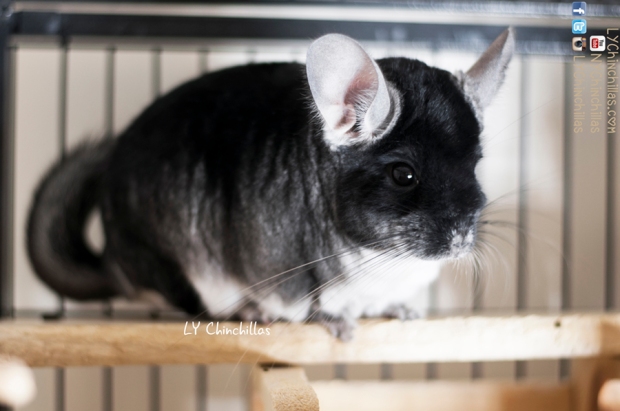
Step 7: Keep in contact and repeat as needed! As the sourcing part of this process can be quite intense, it’s best to maintain great relations with your chin-sitter and keep in touch, as you never know when your travel bug will catch up with you again.
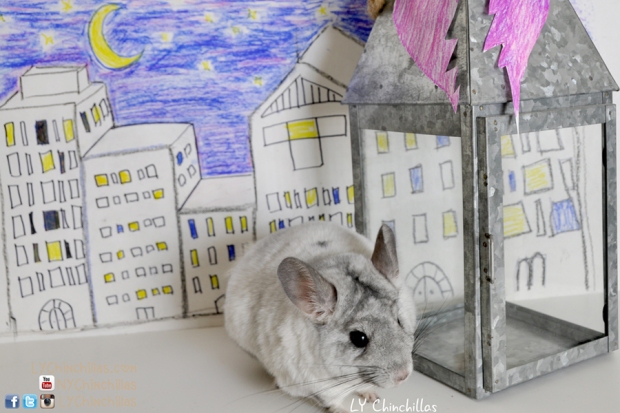
There you have it; the 7 steps to take when selecting and utilizing a chinchilla babysitter. Of course, use your sitters as sparingly as possible: chin-sitting is time and energy consuming, and only you know your chins best! 🙂 As with all exotic pets with specific needs, chinchillas require very willing and knowledgeable sitters, but most pet lovers can be trained with adequate time and accurate information over time. Happy travels, chin-lovers – and make sure your lovely fluffs are safe at home for when you return!

LY Chinchillas Treat Donation
Donate healthy, delicious treats to LY Chinchillas to help keep our content going!
$5.00
Over the year, we’ve had some great topics and fun things to write about! Located on our Favorite Topics page, we wanted to share with you our most poignant and important posts that have helped out our furry friends and their owners the most. The entries are linked so you can click through and read whichever article you find most helpful!
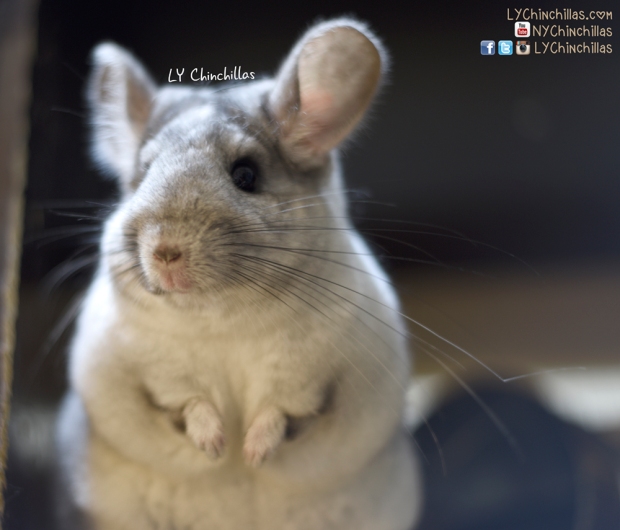
What’s a Chinchilla?
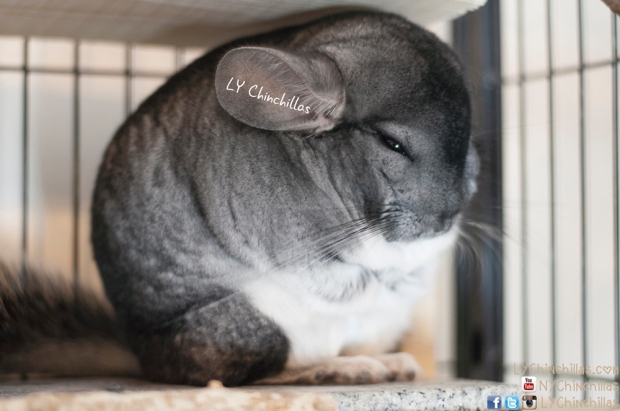
Chinchilla Health
Chinchilla Care
Chinchilla Food
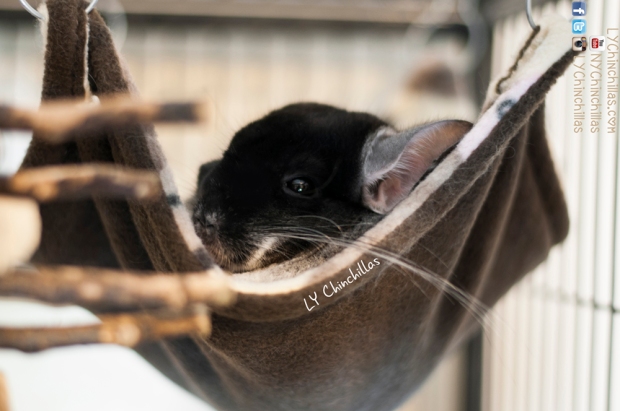
Custom Chinchilla Cages
Chinchilla Cage Accents
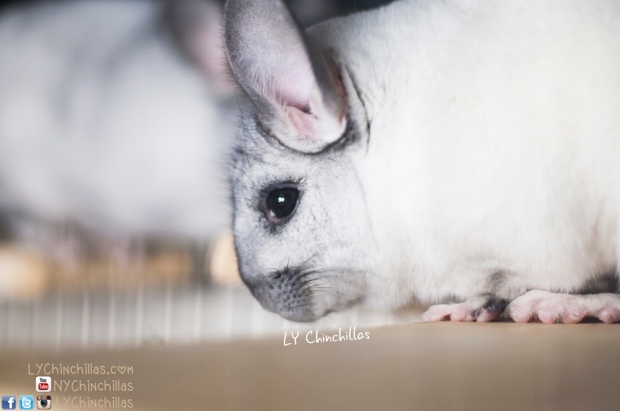
Chinchilla Playtime
LY Chinchillas: About Us!
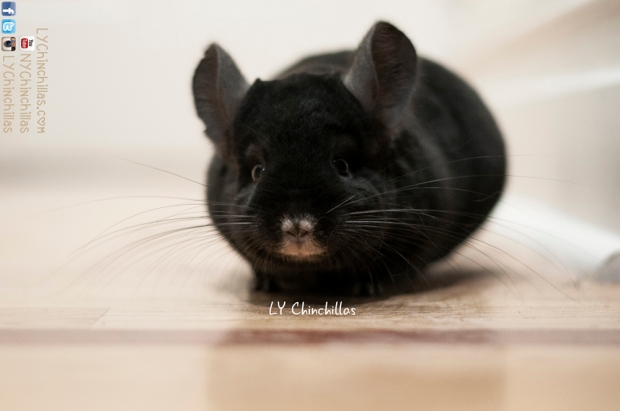
As always, don’t forget to reach out and stay in touch with LY Chinchillas on social media! We’re on YouTube, Facebook, Instagram, Vine, and Twitter!
We’ll be sure to update the Favorite Topics page as time goes on, so don’t forget to leave us some commentary and follow the blog! 🙂
Litter training a chinchilla is possible, but success depends on your chinchilla’s personality. A chin that likes order in their home will typically be well-receptive to training, whereas the more throw-caution-to-the-wind personalities might not take to litter boxes quite as well. Still, there are a few tips that may help the success of training – the most important of which is the litter box, repetition, and consistency. Of course, the training we’re talking about is for #1 only! 😉

So, while I’m in the process of changing cages (yes, it’s happening and no, I’m not entirely sure how I feel about it yet), I decided to re-imagine my litter boxes. In my custom cages, I had pseudo litter boxes, sectioning off a corner of each cage with pine frames and filling it with chinchilla-safe bedding. My favorite bedding is Eco-Bedding: a safe, recycled bedding that resembles crinkled recycled paper (or, actually, that’s exactly what it is). The chins have been using it for so long that they no longer have any impulse to snack on their bedding. Anyway, I’d decided a while back to construct pine litter boxes in place of the faux box structure, and this is what I came up with!

Step 1: Tools!

Step 2: Construct!
With a drill, screw your pine pieces together to create your desired shape. It’s best to use a countersink method, which better hides the screws in the wood. After creating your shape, outline the box’s perimeter against a piece of cardboard and use a box cutter to cut the shape out. Use the staple gun to adhere the cardboard to the bottom of your box, using as few staples as possible to achieve a secure bottom. I use one staple in each corner and then hammer them in to make sure they are secure and impossible to remove without a screwdriver and some leverage. Finally, I use a drill to make a small hole on the side(s) of the box and insert the eye hook(s), which keeps the litter box secure to the cage corner. I use potential plurals, because cages can be different and may need more than one hook to stay in place. I have found that one hook works fine in my cages, because the bars are 1″ and the hook width-wise is 1.25″, meaning the hook would have to be turned vertically in order to be removed from the cage. However, an alternative is using a wing nut, washer, and machine screw – a common technique for removable shelving and other chin items.

Step 3: Set Up!
The best way to introduce a litter box is to secure it to a corner of your cage, filling the box halfway with clean bedding and topping it off with soiled bedding. Since chinchillas have excellent sense of smell and smell is tied heavily to memory, the scent of their soiled bedding will encourage them to return to the same place to urinate. Of course, some chins will dig all the bedding out and trample all over it – the best way to move forward is simply to place the bedding back and continue to encourage the use of the box. It may take a few weeks, and it’s possible that it simply may not work for your chins, but the only way to know for sure is to keep going and display consistency as an owner. The cardboard will have to be changed out every 1-2 weeks, but it serves as an absorptive layer that retains scent and reinforces the training – and also tracks progress. Of course, you could use wood as a bottom, but all organic materials will also require changing out over time. To start off and build a new habit, the cardboard is a great and inexpensive way to encourage repeat behavior. A side note: please watch for cardboard ingestion. At the dimensions and with the installation of my litter box, it’s not possible for my chins to flip the box in order to reach the cardboard, but depending on your shape and method of adherence to your cage, cardboard ingestion could be dangerous and lead to blockage.

Step 4: Monitor!
Accidents will happen, that’s expected. When they occur, be sure to clean up the area well enough to remove as much of the scent as possible. Keeping all soiled bedding in the litter box will be the key to eventual success! Of course, there is no one solution for individual chins, but this method has worked for most of my chinchillas, and is continuing to show signs of potential success in the stubborn ones (cough Fifi and Muff). 🙂

Have a great week, all! I’ll be writing about my transition into Ferret Nation cages as soon as I’m able to formulate a solid opinion on the change. 🙂 Cheers!
April 2015 Update: I have switched the cardboard bottoms out with kiln-dried pine! Over time, it became clear to see that the maintenance of cardboard was too frequent to be efficient. Pine will have to be switched out every several months, as opposed to every week with the cardboard bottoms. 🙂

LY Chinchillas Treat Donation
Donate healthy, delicious treats to LY Chinchillas to help keep our content going!
$5.00
This week’s post goes back to basics, but dust baths are a fundamental and important grooming topic to touch upon. There are always a plethora of questions that curious animal lovers or new chinchilla owners ask (you can find a complete one-stop post about Chinchilla Basics 101 here), and one of the major grooming questions always pertains to dusting! Not only is it necessary, it’s vicious, voracious, messy, wild, and scurrying adorable!

What is a Dust Bath? A dust bath is a cleaning technique used by chinchillas (and other select avian and mammalian species). This type of waterless bathing utilizes dust or fine sand.
Why Do Chinchillas Need to Dust? Since chinchillas have incredibly dense fur and originate from a cool, dry climate in the South American Andes, their fur is not meant to be immersed in water. Water is considered harmful and any immersion could cause fur loss, stress, fungal infections, and lead to overheating. Dusting is important for chinchillas to stay clean, remove any impurities from their fur, and prevent matting. Dusting helps remove unnecessary oils and dirt, and also serves as a form of temperature regulation, meaning it assists in keeping your chin cool and dry by preventing a buildup of heat-trapping irregularities (dirt, oil, heaviness, impurities).

How Often Should Chinchillas Dust? Dusting frequency varies on humidity, season, and some other factors. Typically, the range goes from 2 times a week to every single day. In areas that are humid and during warm seasons, the more frequent the dusting should be. As long as your chinchilla doesn’t have any dry skin problems, it’s safe to dust them daily. I dust my chins every day because 1. we live in an area of fluctuating humidity 2. they don’t have any dry skin issues and 3. they all love to dust. We’ve incorporated it into our daily weighing routine.
How Long Should Chinchillas Dust For? 5-10 minutes is a great amount of time. In my experience, they won’t dust all at once; oftentimes they’ll dust, prance around, shake it off, dust and repeat. Makes for quite a lovely mess!
What Type of Dust Should I Use? I recommend Blue Cloud Dust, which is a very fine natural powder mined from the Blue Cloud Mine in Southern California. The dust has a very high standard of quality, shakes out of chinchilla fur, and also carries a natural, clean scent. This dust can be found in bulk online through various chinchilla vendors or in smaller quantities at commercial pet stores.
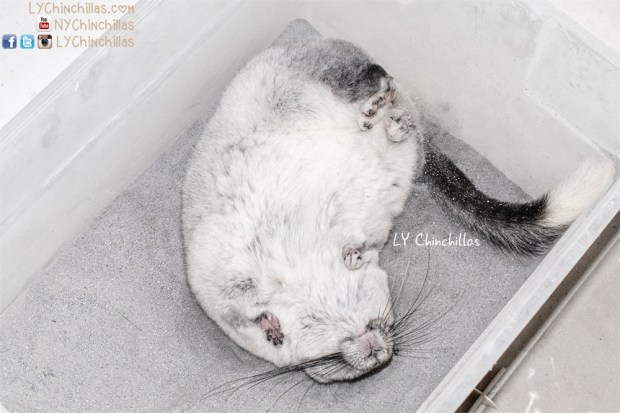
How Much Dust Per Session? I use 1-2 cups of dust and refill as needed.
Where Should I Dust My Chinchilla? I suggest a confined area that would be easy to clean and has ventilation. In my experience, bathtubs and bathrooms work great and have minimal clean-up time. It’s important to note that dust goes flying, gets everywhere, and it will be a struggle to maintain a dust-free environment, so keeping the dust bath far from electronics would be beneficial.

What Type of Dust Bath Container is Best? Of course, glass, ceramic, or metal is great – the most important factor being that the container won’t fall over under the weight of massive chinchilla rolls. Personally, since I’m constantly monitoring them during their dust sessions and do not keep a dust house in their cages, I use an open plastic bin that measures 16″ x 12″ x 7″ and for the most part, I leave the top off or partially covered to minimize dust-plosions. I’d suggest staying away from plastics in general, unless you are present and watchful in monitoring to prevent potential chewing. There are also a plethora of other choices, both for outside and inside of the cage usage – some chin owner favorites include bread pans, smaller cages, and large bowls with sturdy bottoms.

Can I Reuse Dust? For the most part, yes. As long as the quality of the dust is the same, it’s safe to continue using and simply adding in some new dust each session. When chinchillas leave behind some poop, it’s easy to use a scooper or strainer to remove them from the dust. Sometimes, chins will urinate in the dust after they’re done to mark their territory. In those cases, I recommend spot-cleaning to remove the affected dust, pouring out the clean dust, and cleaning out the container before using again (it may be easier to just toss it all out, clean the container, and add new dust). Also, it’s time to change the dust if you notice dust particles clumping together due to retaining moisture over time. My mosaic girls will also leave behind loose strands of their constantly shedding fur, so if I begin to see those, I’ll change out the dust.

Chinchilla Dust Hacks! Does your chinchilla have a light-colored mutation or have urine stains on their furry behinds? You can add a tablespoon of corn starch to their dust bath to help lighten up those stains! Also, you can use a damp cloth or unscented baby wipe to clean stained areas, making sure that you are cleaning the surface areas only and monitoring them until their fur is fully dry.

Can Chinchillas Take Water Baths? As long as your chinchilla is in good health, the answer is no: they shouldn’t. However, certain extenuating health issues may allow owners to bathe their chinchillas in water – please consult a trusted exotic vet and/or trusted chinchilla savants to determine that a water bath is necessary prior to making this decision. Please note that urine stains are no a reason to bathe your chin in water, as there are existing solutions that do not put your chin’s health in harm’s way unnecessarily.
How Should I Store Chinchilla Dust? You should store your dust in an airtight container and keep it in a cool, dry place to ensure maximal usability!

Happy dusting! Stay tuned for more chinformative chinformation! 🙂

LY Chinchillas Treat Donation
Donate healthy, delicious treats to LY Chinchillas to help keep our content going!
$5.00
To celebrate the inevitable approach of spring – finally! – I’ve decided to share my chinchilla cookie recipe with everyone, so that our fur babies can have a delicious treat to celebrate with us! My mentality about these baked treats is more “baked” than “treat” – offering your chinchillas their daily diet in a different form or composition is a great way to encourage healthy eating habits and boost consumption! Diversifying is always a fun way to prevent boredom, too. These cookies are simple to make, and fun to consume.
Chinchilla Cookies

Makes 20-25 Small Cookies
Prep Time: 20 minutes / Bake Time: 2 hours
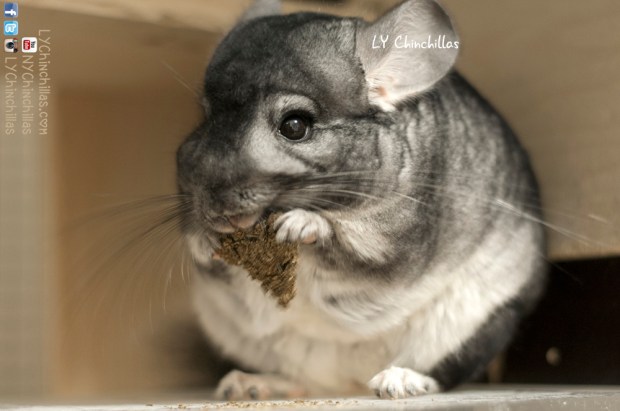
DOUGH: For the base of my cookie dough, I use a mix of pellets and hays. Since my chins’ diet consists of Manna Pro and Mazuri, I like to use 1 cup Mazuri and 1/2 cup Manna Pro. You can use the chin feed your chinchillas prefer! Mix the pellets with a variety of hays: a combination of Timothy and Alfalfa hay “dust” – you know, the leafy, dusty, tiny particles left over from hay bags. Sift through the hay dust to remove larger stems, as they won’t hold well in the dough. Place the 1.5 cup of pellets and 1.5 cup of hay dust in a food processor or blender, and blend until everything becomes a fine powder.

ADDITIONS: Place the mixture into a stirring bowl and add in one tablespoon of cold-milled ground flax seed and 1/8 cup of organic rolled oats. Separately, I prepare my water mixture, with 9 parts water to 1 part unsweetened apple juice (I use a juice press to press the juice from fresh fiji apples, for taste).

MIXING: I make sure all the dry elements are well-mixed, and begin adding in my water/apple juice mixture little by little, kneading the dough as I go. Hays and pellets have an absorptive reaction, so kneading by hand is the best way to tell how saturated the dough is.

REFRIGERATE: When the dough is at a cookie dough consistency, I place the mixture into a plastic bag. Then, I flatten the dough in the bag and refrigerate for several hours in order for the dough to set and become more easily mold-able (this refrigeration step is optional, but recommended).
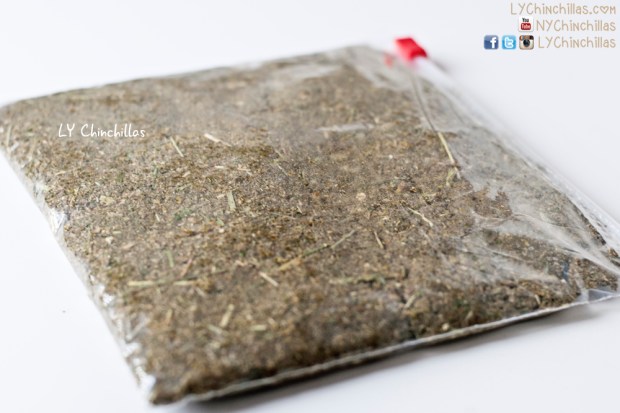
MOLDING: When I’m ready, I’ll make small balls of dough, press them flat, and use a rolling pin to flatten the cookies evenly. I personally don’t use cookie cutters, because I prefer the natural shape each cookie has – but I’m sure they would be adorable if you chose to use shapes. Keep in mind that due to the consistency of the dough, it’ll probably take some time to form your cookies into dense enough shapes to bake successfully.

BAKING: Finally, I’ll bake the cookies at 200 degrees for approximately 2 hours – don’t forget to check the oven from time to time to gauge the cookie’s status. The low heat prevents burning, while allowing the cookie to fully bake through. Mold during storage can be a problem for home-cooked chinchilla goods if the water content has not been adequately baked out, so it’s important to make sure the final cookies are dry and brittle. Also, chins love the crunch!

STORAGE: Remove the cookies from the oven and allow them to dry overnight at room temperature. Keep cookies stored in an airtight food container in the freezer and serve as needed for a delicious treat! Since most of the moisture content has been baked out of the treats, freezer storage does very little to alter them.

There you go! Healthy cookies for your fluffballs. There are plenty of other versions out there that include pumpkin puree or molasses, but we opt for a more basic cookie treat that isn’t too much of a guilty pleasure! My chins enjoy 2-3 cookies per week as a supplement to their existing diet – although adding in these cookies means decreasing all other treat consumption. Cheers! 🙂


LY Chinchillas Treat Donation
Donate healthy, delicious treats to LY Chinchillas to help keep our content going!
$5.00
FIFI [my wildcard!] AKA Feef, Fluff-Monster
Mosaic, Born 08/21/2013, approximately 700 grams

Role in Playtime Kingdom? Hyper, speeding fluff bullet! Aside from zooming around, she’ll also try and find any corner to bury her adorable face in. In a way, she’s like the speedy prisoner of the kingdom, but only because she created that role for herself in her own mind. Most of the time, she scares herself!
Favorite Hiding Place? Any tight space, far from the reach of humans. She enjoys following her sister Lulu around during playtime, but will be the first to dart behind any object at the first hint of feeling threatened (i.e. any soft, meandering human shuffle will warrant a disappearance)!

Physical Capability? Fast as a speeding Fifi! This darling will bolt, squirm, wriggle, jump, and burrow like every day is her last. Her strength is her awesome speed, followed by some wall surfing. Her physical capability comes from her level of personal anxiety – I know this because she comes from a sweet home, has the sweetest sister, and has a sweet mom that spoils her at every turn (me!). Despite her loving conditions, Fifi has a sometimes frustrating attitude that attempts to antagonize every situation before even reading it!

Vocal? She’ll bark if she’s in her cage, because she never wants to come out for weighing, dusting, or playtime – but when she’s out, she’s really quite sweet.
Human Cuddle Status? Trust is a problem with Fifi, unlike her loving sister. So, she gets all her cuddles in with Lulu in the cage.
Favorite Way to Be Picked Up? Not applicable! Fifi hates being picked up, but if imperative, it would be by the torso and base of the tail – just like Lulu.
Intelligence? Unknown. I believe Fifi is intelligent, but it’s clouded behind her anxiety and fear. Such a shame! I hope that over time – I’m talking years and being hopeful in that sentiment – she’ll be able to relax and come to terms with the fact that she’s always very safe with mom.
Is She Compatible with Other Chinchillas? Not really. She’s a sweetheart with her sister, but she’s too unstable to trust with any other chinchilla.

Ready for a Photo Shoot? No.. you’ll notice a lot of Fifi’s photos are either taken while she’s in the cage or having a very rare calm moment – although this lady is extremely photogenic when she’s able to be captured!

Love to Dust? She’ll give it a roll or two, but she’s not crazy about dusting.
Three Words/Phrases to Sum Up Her Personality? Beauty and the Beast, Speedy Feefzales, Drama Queen 😀
Next Week.. Koko Bear!

LY Chinchillas Treat Donation
Donate healthy, delicious treats to LY Chinchillas to help keep our content going!
$5.00
An often overlooked aspect of chinchilla ownership is weighing your chinchilla. While it’s not imminently necessary if you have a healthy chinchilla, owners often regret not weighing them once an illness or injury has occurred. Because chinchillas don’t show too many visual cues, weight is a great albeit general way to see how everything is doing with your chin. In addition to weight, behavior, consumption, and digestive output (poop!) are important elements to consistently monitor – they’re major cues to any potential problems.
There are only a few simple steps to successfully weighing your chinchilla.
Buy a Scale: Scales are easy to purchase in stores or online, and relatively inexpensive (around $30). I use a digital kitchen and food scale that weigh items (and chinchillas) up to 10-12 lbs. Most chinchillas weigh under 4 pounds, so these scales are more than adequate for your chin-kids. There are many different styles; some have circular platforms, rectangular, oval, and even curved platforms, which many owners love because of its harder-for-chinchillas-to-escape design. I use an Ozeri brand food scale with a circular surface, and it works well for my round babies.

Be Consistent: It’s important to weigh your chinchilla from time to time in order to utilize the aspect of weight in your chinchilla’s health. Each owner has their own routine: some weigh monthly, weekly, or from time to time when they suspect any health problems. Personally, I try to weigh my chinchillas every day. I feel that the routine helps me bond with my chins and build a level of baseline interaction. Interaction is more important than weight, as it helps you understand any variations in your chinchilla’s behavior (which, if acutely different, should be checked out by an exotic vet). I try and weigh my chinchillas at roughly the same time of the day – although it doesn’t necessarily guarantee consistent results, I try to keep my variables as close to a baseline as possible.

Understand Variation: Due to consumption, time of day, and slightly altering routines, your chin’s weight can fluctuate daily, upwards of 15-20 grams! It’s important to note that weight is only one indicator of many to your chin’s health. Most of the time, any weight lost yesterday will be replaced tomorrow. My rule is, if there are no changes in consumption, poops, or behavior, then I’ll give my chins one week to bring their weight back up before considering further action. If there’s weight loss coupled with a negative change in any of the other three indicators, I’ll give 2-3 days for self-recovery prior to a vet visit. If there’s weight loss coupled with obvious injury or a more acute drop in consumption or behavior, I’ll schedule a visit for the next day. Growth slows over time and chinchillas are considered full-grown around 8-18 months old; prior to then, chins should be gaining weight steadily over time. Once full-grown, chins should be maintaining their weights or slightly increasing with slight variation. For LY Chinchillas, Mittenmaus is leading the way at 835 grams and Koko ties Fifi for last place at 663 grams! Aside from controllable factors like diet and exercise, uncontrollable factors like genetics and age always have something to do with weight; that’s important to remember.

The Weighing Process: You only need your chinchilla to be still for 2-3 seconds on the scale in order to successfully record your data. This process can be quite tough for most people, as chinchillas are skittish and hate standing still! Many owners like to tempt stillness with a safe treat – however, with daily weighing, I’ve opted out of the treat option and learned how to hone the chinchillas without any treats. Like many things with chinchilla ownership, the first step is patience. Of course, you’ll want to set your scale to measure in grams, which is the most common unit of measure for these little guys. After that, get familiar with your scale and keep your weight notebook nearby. At that point, these are my steps:
1. I dust my chinchilla. Because we live in an area of relative humidity and none of my chinchillas have dry skin problems (and love to dust), this is added on to my daily routine. This step disorients them a little, and they’ve just exuded a little bit of energy rolling themselves around and getting dizzy. If you’re not able to dust daily or daily dusting isn’t needed due to your geography and preference, then this step can be skipped.

2. I carefully lift my chinchilla and place him/her on the scale. I handle them either with them willingly standing on my palm to be transported – see Muff above, or being held gently by the torso and base of the tail – see Lulu above. The scale is located 3-4 feet from their cages; minimizing distance traveled helps the process be as seamless as possible. Patience is key here, as after they are oriented, they’ll try to scurry away and jet. I’ll steady the chinchilla, making sure the tail is lifted and not touching the ground (if the tail is resting on a surface, it will take pressure off the scale and the chinchilla will end up weighing 10-20 grams less) and lift my hands away, keeping a sharp eye on the number and the chin. I’ll try this four or five times if the chinchilla is being uncooperative, cupping my hands around the chin until he/she is still and then removing my hands in an attempt for a quick read. If a chin really isn’t in the mood to stay still, I’ll return the unwilling participant to his or her cage and try again later. At this point, since the scale is part of their daily routine, I have minimal problems and it’s a rare day if I have a chin behaving badly.

3. I record their weights. After successful weighing, I won’t have enough time to write their number down. Instead, I’ll memorize the number and place the chinchilla back in their cage, often with a little willow twig or apple stick as a safe chewy reward. After they’re safely in their cage, I’ll write their number down and do a quick comparison. If the number is not showing a steep or steady decline, I’ll continue on the daily routine without worry.

4. I analyze the numbers! Every week or two, I’ll enter these numbers in an Excel spreadsheet and graph the bad boys just for some visual fun! Working with numbers isn’t exactly the most exciting thing, so it’s always rewarding to watch the numbers grow and change over time!

Another method which has been successful for owners (but requires some minimal math or resetting of your scale settings) is to place a container on your scale that more easily confines your chinchilla, then weigh your chinchilla and subtract the weight of the container. This method helps minimize the need to manually contain your chinchilla, although you may need to try this method several times as well, due to any shifting weight or escape attempts. Stillness is key to a successful weighing, and most chins won’t let you succeed too easily! Patience is key to unlocking your chinchilla’s weight, and a can-do attitude never hurts!
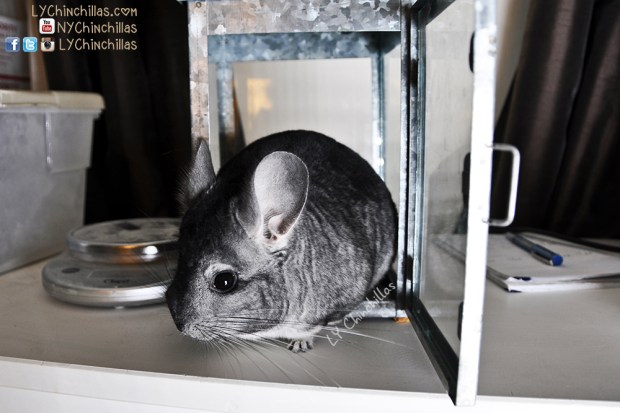

LY Chinchillas Treat Donation
Donate healthy, delicious treats to LY Chinchillas to help keep our content going!
$5.00
Here we are traipsing the threshold of 2015, and it’s golden skies and sunny days as far as the eye can see (optimism, optimism!). Instead of writing a post on this year’s reflection (which, if you do want to read, I’ve already written), I’m going to instead share something that could be useful to you and your sweet furry pets in the new year – especially for all you new chinchilla owners. Today’s post will be all about best bonding practices!
There are a few major pointers I’d like to make to cast an umbrella over the whole of this post, which I think are good fundamental rules to follow in the entirety of your relationship with your pet:
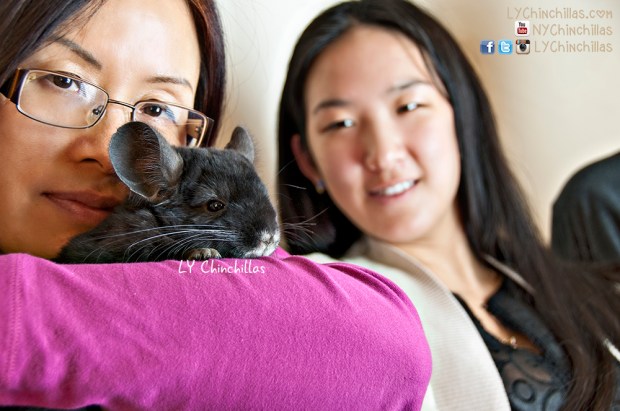
Step 1: Introductions! When you first meet your darling chinchilla(s), there will be a great deal of confusion on their end. They’ve likely been through the ringer on the first day in their new home, what with transport, new smells, sounds, and vibrations. Hopefully, their last owner provided you with some of their pellets so you can make an eventual transition to their new feed over the course of several weeks. If not, they’ll have the added stress of a new diet to deal with. It’s important to be understanding during the first few weeks. They will be understandably skittish and scared – but don’t worry, chinchillas are extremely adaptable, resilient, and curious, and will come to know their cage and environment within a day or two. Some owners have found that having a television on by the cage has helped alleviate stress during a move and acted as a distraction for their chinchillas during times of change. In this initial introductory period, you should spend time around your chinchilla, but should not force them to leave their cage or be unwillingly held if not needed. It’s always helpful to speak quietly to your chinchilla in a calming voice, allowing them to become familiarized to your baseline temperament. Once your chinchilla begins to feel safe and the introductory period is nearing an end, you’ll notice your chinchilla approaching you with curiosity and willingness. In some cases, this can happen almost immediately with a very social and friendly chin – in most cases, the process takes much longer, up to several months. In the meantime, it’s time for Step 2.

Step 2: Develop a Routine! Adopt a healthy diet, dusting routine, and cleaning schedule for your chinchillas. Feeding your chins should be a daily exercise. Free feeding pellets is the way to go; hays and pellets should be re-upped every day to ensure maximal freshness. When you’re in the cage, be sure to say hi to your chinchilla and remind them what a great job you’re doing as a parent. As far as dusting goes, since my chinchillas don’t have dry skin issues and all love to dust, I have a dust compartment separate from their cages that I allow them access to every day. Since it’s a controlled dusting environment and not a free-for-all, I use their dusting time as an opportunity to pick them up, hold them briefly, and weigh them daily. I’ve found that this daily routine has helped me bond with my chin-kids, learning how they like to be picked up, how long they can tolerate a cuddle, and reassuring them that I’m still here for them. Additionally, it’s helpful to objectively weigh their growth – based on water and food consumption and time of day, chinchillas can gain or lose up to 20 grams per day, but as long as the overall trajectory is weight gain and not loss, there isn’t much to worry about. All chin owners know that cleaning is needed almost daily. Deep cleaning occurs perhaps once or twice a week, but some minor tidying is a daily task. During this time, I like to sing to my chins, even though human bystanders insist they’re begging me to stop (I know the truth: that they LOVE it). The importance of routine cannot be overlooked – it’s the daily interactions that amount to aggregate care. Nobody said caring for a chinchilla was easy, and if they did, they were wrong! It does gets easier though, once you adopt a manageable schedule and supportive network.

Step 3: Playtime! Given your chinchilla is over 6 months old, you can let them out for playtime once or twice a week. Eventually, as long as you have the time and energy to supervise a safe playtime session and know your chinchilla well enough, even daily playtime is fine. I’d suggest starting out in a bathroom or closet for 10 minutes at a time, sitting with them and allowing them to learn and explore the space before moving on to a larger area. To read more about playtime tips, read this post. Not every chinchilla is fond of playtime, some prefer their cage. However, playtime is always a great way to boost trust and confidence in one another, getting to know your little friend through exploration. The more attention and interaction you give your chinchilla, the better their quality of life and the more satisfied they’ll be in their home. Boredom can be a killer for any species, especially for intelligent, active, caged chinchillas. Stimulation is critical for their health and happiness – physical activity can help ebb the issue of containment or inactivity. Hopefully, in addition to a great playtime, your chinchillas have access to a large, spacious, and fun cage where they can explore, chew, and entertain themselves during your off hours. If not, you can look into building your own cage for them! It’s a lot of work, but a lot of reward as well.
Step 4: Lots of Love! There are a plethora of ways to continue on the bonding process. Offering scratches to your chinchillas behind the ears and under the chin can be a great way to bond! For chinnies that don’t want to be scratched, chew toys are always a great peace offering. Teaching your chins that you feed them, bathe them, and treat them helps to develop a great maternal or paternal relationship with your chin-kid. Essentially, any amount of quality time spent with your chinchilla serves to improve human-chinchilla relations, bringing you and your chin closer each day. It’s the little successes that often make us happiest, since these little critters can’t speak or sing or shout about how much they love us. There’s really nothing that can replace the time and energy spent towards great care. We can only do the very best that we can do. Your chinchillas will come to respect you and appreciate you, and simply take you for granted. But, isn’t that just the joy of it all anyhow? You see, that’s the ultimate takeaway from all the hard work that goes into bonding with your chinchilla. You’ve just come to the end of this lengthy article on bonding, but the truth is, if you are a great pet owner, you’ll do everything you can for the animals you love, expecting absolutely nothing in return. Just safety, health, and happiness! That’s our motto – Happy 2015 ya’ll!

Don’t forget to keep in touch with us – YouTube, Facebook, Instagram andTwitter! Follow us into the New Year! 🙂

LY Chinchillas Treat Donation
Donate healthy, delicious treats to LY Chinchillas to help keep our content going!
$5.00